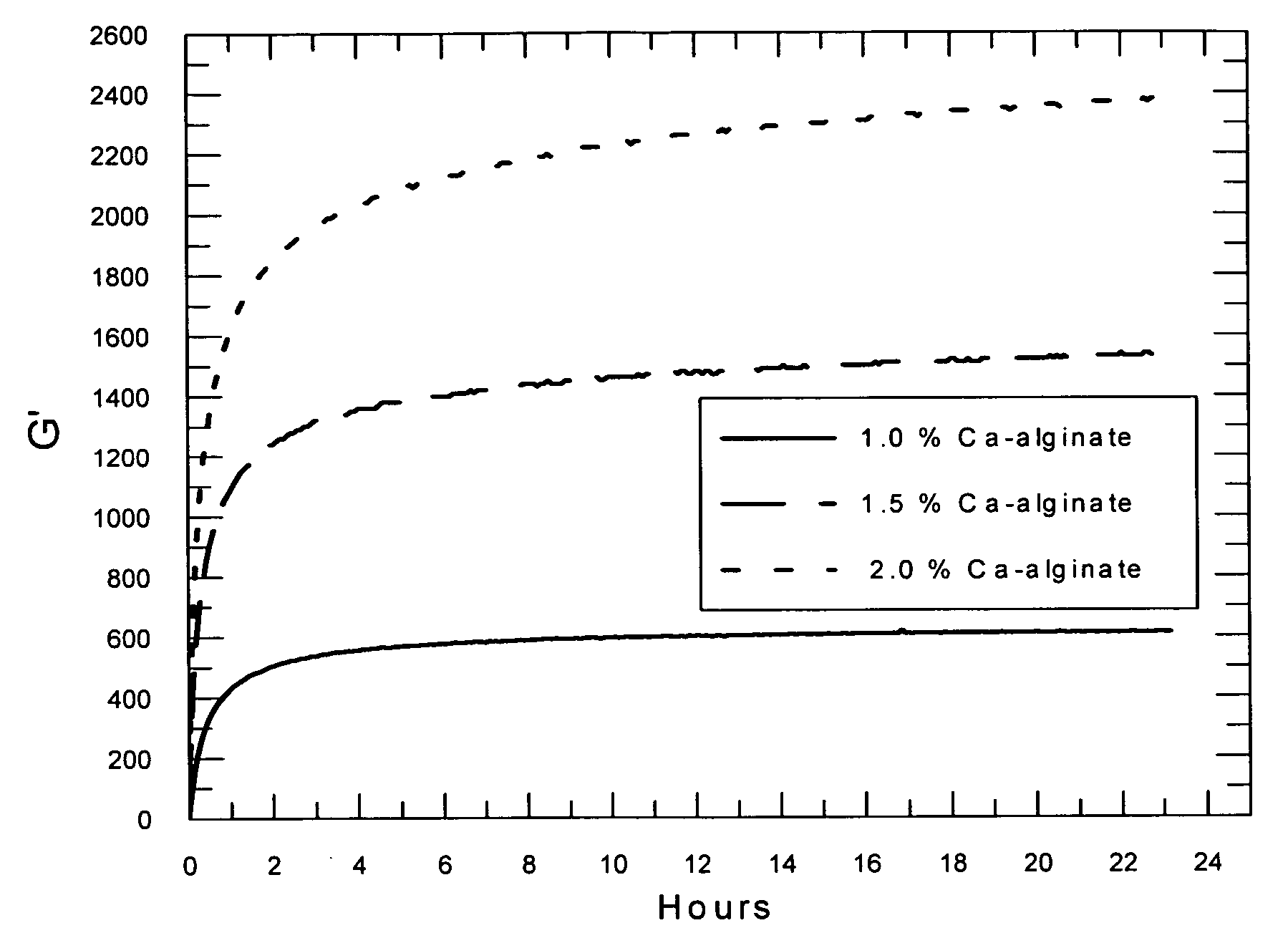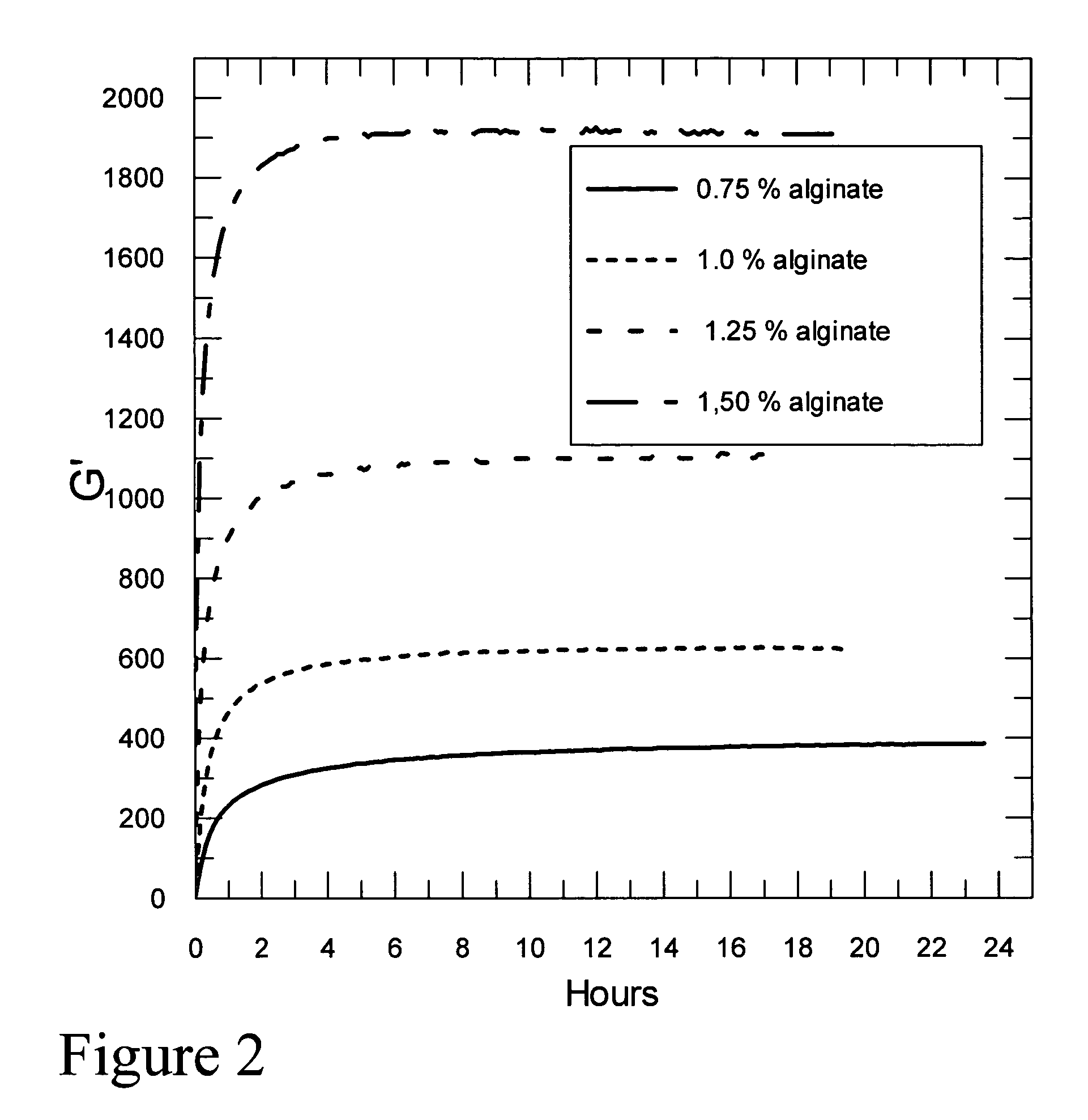Self-gelling alginate systems and uses thereof
- Summary
- Abstract
- Description
- Claims
- Application Information
AI Technical Summary
Benefits of technology
Problems solved by technology
Method used
Image
Examples
example 1
Gelling with Different Calcium Concentrations
[0081] In this experiment gels were made by mixing a solution of sodium alginate (Protanal SF 120) and a calcium alginate dispersion (Protaweld TX 120). The amount of calcium alginate was varied (1.0%, 1.5% or 2.0% in the gel), while the amount of sodium alginate was constant (1.0% in the gel). The setting of the self gelling system during time was measured by using a Physica MCR 300 rheometer (Measuring system: PP50, serrated, Temperature: 20° C., Gap: 1 mm, Frequency: 1 Hz, Strain: 0.005). The solution and dispersion were mixed immediately before addition of a 3 ml sample to the rheometer, and the oscillation test was performed over a period of 18-24 hours.
[0082] As shown in FIG. 1, the gel strength increased rapidly with time during the first 1-2 hours, and thereafter the change in gel strength was reduced as the gel showed a tendency to stabilize. The data also shows that the gel strength was increased at the higher calcium concentr...
example 2
Gelling with Different Alginate Concentrations
[0083] Alginate self gelling systems were made by mixing a solution of sodium alginate (Protanal SF 120) with a suspension of calcium alginate and measurements performed as described in Example 1. Oscillation measurements were made over a period of 18-24 hours. Equal amounts of sodium alginate (Protanal SF 120) and calcium alginate (Protaweld TX 120) were used. The amount of sodium alginate and calcium alginate was each adjusted to be 0.75%, 1%, 1.25% and 1.5% in the final gel respectively (FIG. 2). The gelling kinetics followed a similar pattern in all four cases. However, as in Example 1 the gel strength clearly increased with increasing alginate concentrations.
example 3
Gelling with Alginates of Different Molecular Weight
[0084] In this experiment the gelling kinetics for sodium- and calcium alginates with different molecular weight was compared (FIG. 3). A reduced MW sample of the alginate (Protaweld TX 120) was obtained by increasing the temperature for several days (FIG. 3, Panel A) Protanal SF 120 and Protanal SF / LF sodium alginates with different MW were also compared (FIG. 3, Panel B). Rheological measurements were performed as described in Example 1 and the data are shown in FIG. 3. As shown in the figure the gelling process was clearly dependent upon the alginate molecular weight both for sodium and calcium alginate. In both cases the gel strength increased more rapidly for the high molecular weight alginate and also reached a higher level. Similarly to what is seen in FIG. 3, FIG. 11 also shows gelling of a reduced MW sample of sodium alginate (PRONOVA UP G 100) obtained by increasing the temperature. However, in this case gelling was init...
PUM
| Property | Measurement | Unit |
|---|---|---|
| Thickness | aaaaa | aaaaa |
| Thickness | aaaaa | aaaaa |
| Particle size | aaaaa | aaaaa |
Abstract
Description
Claims
Application Information
 Login to View More
Login to View More - R&D
- Intellectual Property
- Life Sciences
- Materials
- Tech Scout
- Unparalleled Data Quality
- Higher Quality Content
- 60% Fewer Hallucinations
Browse by: Latest US Patents, China's latest patents, Technical Efficacy Thesaurus, Application Domain, Technology Topic, Popular Technical Reports.
© 2025 PatSnap. All rights reserved.Legal|Privacy policy|Modern Slavery Act Transparency Statement|Sitemap|About US| Contact US: help@patsnap.com



